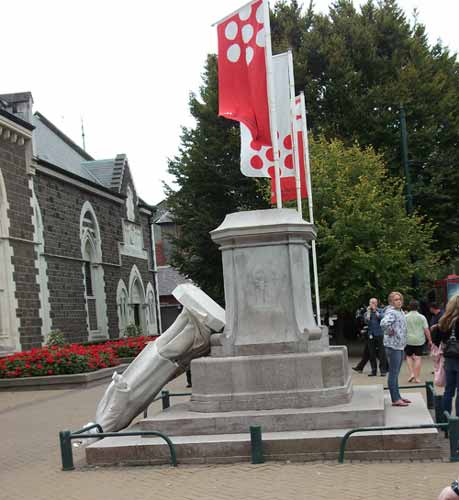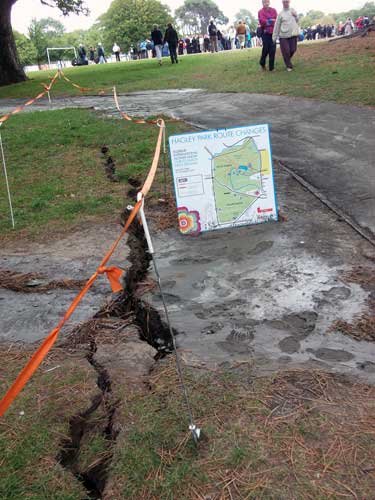BGS geologist caught up in Christchurch earthquake
Twenty-nine geologists from Nottingham were caught up in the 6.3 Mw earthquake of 21st February 2011 while on a 'geotour' holiday of New Zealand.
BGS geologist Dave Wilson recounts his story of one of New Zealand's most devastating earthquakes:
'On a wall in the Natural History Gallery of Auckland Museum I came across a quotation by American historian Will Durant (1885–1981) who wrote that:
'Civilisation exists by geological consent.... subject to change without notice.
Three weeks later at the end of our holiday, while in another museum in Christchurch, I knew exactly what he meant.
Just one enormous bang
It was the last day of our holiday, suitcases were packed and we were killing time before an early evening flight; the weather was overcast and it looked like rain, so indoors seemed the best option.
When the earthquake struck I was in the Canterbury Museum, central Christchurch, looking at an exhibition devoted to a centenary of Antarctic exploration (Christchurch being the stepping-off point for most of it).
It's difficult to describe what it feels like to experience a 6.3 magnitude shallow earthquake at close hand. As BGS geologists we probably look at these things dispassionately; our seismologists record them, measure their magnitude and comment on their likely origin, but being in the middle of a catastrophic quake is rather different.
There was no warning of this earthquake; there was no build-up in the intensity of the tremors, just one enormous bang and a terrific lurch followed immediately by a series of violent jolts that went on for about 15 seconds until they began to slowly subside.
If you can imagine each jolt as one click as someone turned the handle of an enormous ratchet, you may get the picture.
Get me out of here!
We were on the top floor of the museum when it occurred, and were flung across the room. The lights went out and alarms began to sound.
I realised it was an earthquake almost immediately (we'd seen the effects of the September event the previous day), and we made for the exit, but the tremors were such that it was difficult to keep our feet and run in a straight line.
I remember the sound of tables, glass and crockery crashing to the ground in the restaurant next to the gallery, as people rushed out heading for the stairs and emergency exit.
There was no real panic until we found that the emergency doors wouldn't open until a member of the museum staff released them. In retrospect this was a sensible precaution to prevent people rushing out, only to be hit by falling masonry, but with the tremors continuing, it was worrying nevertheless.
Safety of the open spaces
Once outside we moved away from the building. Fortunately the museum backs onto the open space of Christchurch Botanic Gardens, although even here it was not entirely safe as branches fell from trees; in other parts of the gardens we found whole trees had been uprooted.
By this time we were joined by friends and a whole flood of people from Christchurch central business district (about a quarter of a mile away).
Aftershocks came and went every ten minutes or so, some almost as strong as the original tremors.
Files of schoolchildren arrived (they all get earthquake drill at school apparently) and walking wounded, many visibly shocked, on their way to the hospital on the other side of the park.
Eventually there were something like 1500 people gathered there, and we heard stories of how shops, offices and the Cathedral had collapsed, and how people had been trapped.
It was impossible to gauge the scale of the disaster although we knew it was serious from the continuous noise of sirens as injured were ferried to the hospital. I suppose at this stage our main reaction was a feeling of helplessness at not knowing anything other than that within a 200-metre-radius of where we stood.
After a couple of hours, people began to drift away to their homes, and instructions came through to assemble in another part of the park.
'Liquefied' ground
On the way there we saw the liquefaction the shaking had induced. There were fissures in the ground through which small mud 'volcanoes' had developed; parts of the playing fields had flooded and, interestingly, the River Avon (actually a large stream) had risen by about half a metre and was turbid with mud.
Water mains had cracked and there were rifts across tarmac paths and roads.
Red Cross processing
We assembled at a Red Cross centre that had been converted from an aircraft hangar-sized marquee that was due to be used for a forthcoming flower show. However, liquefaction had turned the floor into a sea of mud and we had to wait several hours whilst it was cleaned, boarded and covered to allow people to sit down.
To allow yourself to be processed as a refugee by the Red Cross is an interesting experience, but I now understand why it is necessary.
Once completed the Red Cross are able to inform next-of-kin, arrange accommodation and flights out of the area; they also arrange food and medicine for those who need it. Evacuation is necessary because of the sheer volume of people who need help (in this case, at least 50 000).
The consulates are involved also for those who have lost passports and belongings, and who need repatriation. After the initial confusion in the immediate aftermath of the earthquake, these voluntary organisations (Red Cross, Civil Defence, etc.) take control and, from what I saw, operate in a highly efficient way.
However, I'll not forget the help given by ordinary New Zealanders who offered us food, accommodation, transport, and sympathy even though their lives were equally shaken by the event; they are an extremely resilient people who seem to take this sort of thing in their stride.
Homeward bound
We flew out two days late via Los Angeles; our luggage is still in our hotel in Christchurch. We may get it back if and when the building is safe to enter. New Zealand is a fantastic country and, earthquakes or not, I'd go back there like a shot.

- A Comparison of the Folkestone and Market Rasen Earthquakes
- Seismogenesis and State of Stress in the UK
- Monitoring Volcanic Eruptions Using Interferometry
- Particular events
- Are yesterday's earthquakes tomorrow's disasters?
- Creating 'virtual seismometers' deep inside the Earth
- Is earthquake activity related to the Moon or Sun?
- Is earthquake activity increasing?







